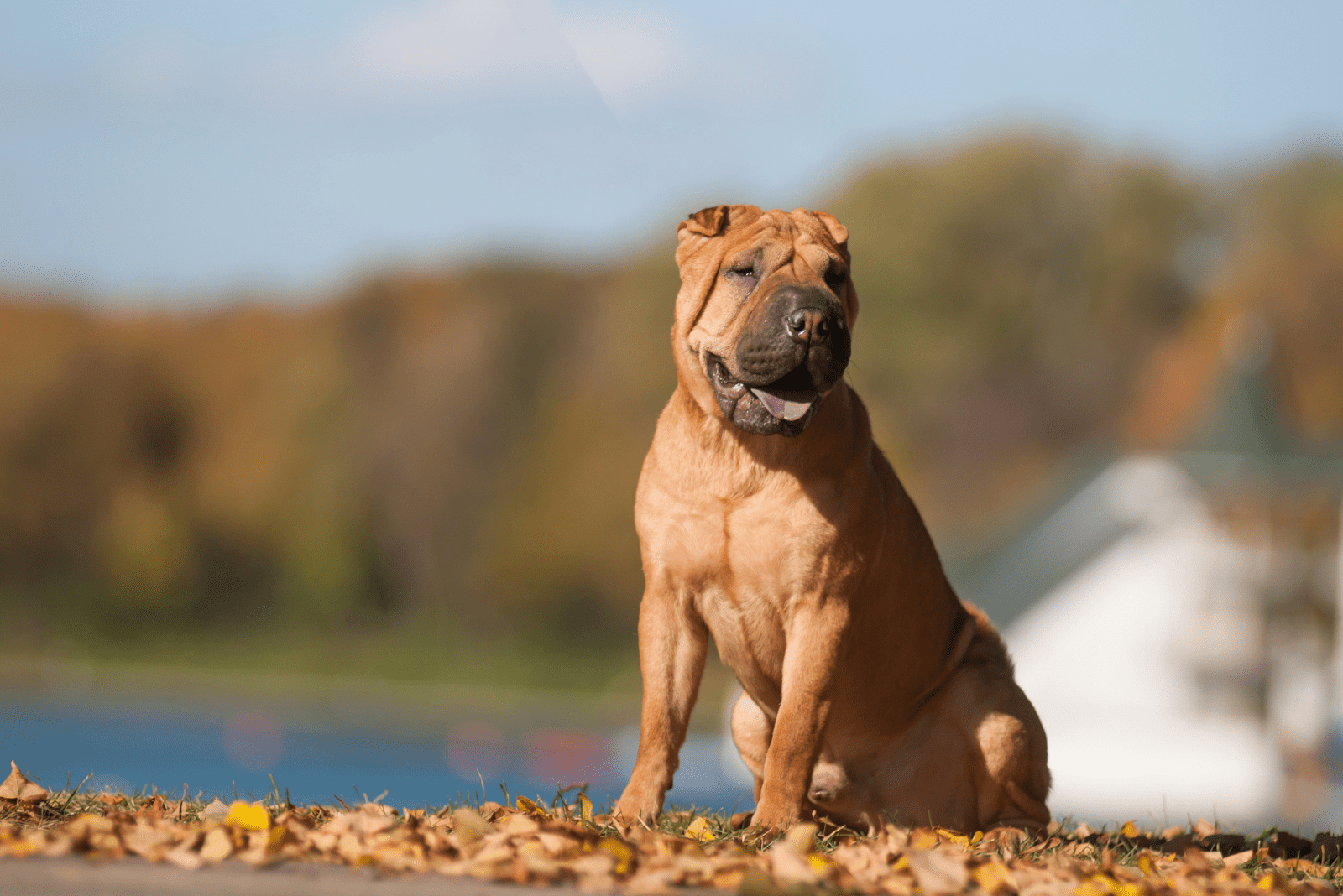The dog best known aesthetically for his many skin folds and his blue-black tongue, but also his loyalty and impressive size, the Chinese Shar-Pei. But how big do dogs of this breed really get? We’ll find out today through the Shar-Pei growth chart.
The Chinese Shar-Pei growth chart represents the average gain of weight and size for the breed throughout his life, from a young age and all the way throughout his adult life, to the end of his senior years.
His entire 9-12 year lifespan is displayed, showing what the desired weight range should be in your dog.
However, it’s not a requirement to be exactly within the margins as there are several factors that can affect the needed estimate, be it the gender of the dog or his overall size.
A smaller size usually means a lower weight requirement and the opposite is true as well.
However, it’s best to consult with your local veterinarian about the ideal dog weight for your furry friend as they can provide you with a better estimate than a chart based around the averages of the whole breed.
They can also tell you whether or not your dog being under or overweight is a sign of some underlying health issues, developmental problems or if it’s normal.
That said, growth and weight charts are always useful as guides, reference points to look back on quickly as the ranges are correct in most cases.
To find out what one of these looks like for the Chinese Shar-Pei as well as find out how his life develops over the years, and finding out answers to some of the most commonly asked questions related to this topic, be sure to read on.
The Shar-Pei Growth Chart For Pups
[table id=654 /]
As we can see here, the rate of growth of a Shar-Pei is pretty standard, only gaining about 5-7 pounds in monthly intervals, and slowing down over time as he becomes an adult dog around month 16.
His height doesn’t really go up that much over the course of this either.
The Shar-Pei will reach his full height at around 9 months of age, at which point he may grow half an inch a month, if at all.
This may seem concerning to someone who may be owning a Shar-Pei for the first time, but this is pretty standard.
Once the Shar-Pei reaches his full height of around 19-ish inches, around 18 for his female counterpart, he’ll continue to fill out the rest of his body over the other half of his young life.
The weight of your Chinese Shar Pei usually reaches its peak at month 16.
Both the weight and growth trajectory start to stagnate in an adult Shar-Pei, the line’s direction mostly depending on diet and amount of physical exercise, or some form of underlying health issue, but, other than that, it remains the same.
The things that will be changing are the amount of cups of dry food you’ll be feeding your dog.
The definition of a balanced diet will shift over time as your dog’s metabolism shifts.
A Chinese Shar-Pei puppy will need to eat a lot more at the start to be able to put on the weight needed, only to slow down as months go by and he reaches adult size.
His metabolism will be working at its peak in the first half of his adulthood, but it will start to slow down as he nears his senior years and the end of his lifespan.
Here’s how it all approximately looks like throughout the years:
0-2 Weeks Of Age

As with every other dog, once they’re born, you’re not the one taking care of them for the first few weeks of their life.
They’re weak and vulnerable and need the care of their mother to power through until they can stand on their own 4 paws.
Your job is to feed the mom so she can provide enough nutrients for herself while also creating the milk needed to feed and nourish her new litter of pups.
You may need to take over for one pup every now and then in case the mom has rejected him, though this only applies to you if you’re a breeder.
Simply get a heating pad that replicates the warmth of his mother’s body, maybe something that can also replicate the beat of a dog’s heart to simulate a familiar rhythm that’ll put the pup more at ease.
You’ll also need a replacement for the mother’s milk to provide him with the nutrients needed for typical growth.
3-8 Weeks Of Age
Teething will start around this time as your dog’s teeth come in, so expect a lot of nibbling as he tries to soothe the irritation.
Over time, as his teeth come in, you’ll have to start weaning the Shar-Pei puppy off his mother’s milk and onto more solid foods.
This is usually done through a gradual introduction process where the dry kibble is mixed in with water to be softened up, making it easier for your dog to pick up and digest.
The ratios are shifted more in favor of the dry dog food over time until it becomes just pure kibble, at which point your dog should be more than used to it by now.
It’s critical that this is done prior to week 8 as that’s usually the point at which he’ll be bought and rehomed, and he won’t have access to his mother’s milk any more.
9-12 Weeks Of Age
Here’s where the responsibility falls to the new Shar-Pei owners, and likely where you’ll be taking over if that’s you.
At this stage, you’ll be expected to continue with the training that the breeder has started.
This mostly refers to behavioral training and socialization for the Shar-Pei as they’re normally not the most friendly to strangers.
Letting them hang around dogs and kids while they’re little can help teach them that not everyone is a threat and will make them more sociable later down the line.
It’s also a good time to teach him right from wrong, a.k.a., what is considered acceptable and what isn’t as a young mind absorbs information a lot easier.
Leash training and potty training are a part of this process too, as well as crate training if you intend to travel anywhere long distance with your dog.
This process is likely to extend further than week 12 if you’ve started later than most, but it should be fine.
You’re also expected to continue using the same dog food that the breeder fed him to avoid any potential issues with the dog rejecting the food.
You can, of course, utilize the same method they did to swap him over from milk to solids to get him over to a new brand.
All you need to do is mix in a little of the new stuff with the old and gradually increase the ratios until it becomes the new food entirely.
It’s that simple, but only do this if there ends up being any issues with the old food or if said food becomes unavailable as it’s just an unnecessary hassle that you can avoid if your dog enjoys his old food just fine.
4-9 Months Of Age
Not much changes in this stage. If you’re keeping your dog on a balanced diet, you should still see the typical rate of dog growth that follows the charts.
The one thing that does happen during this time is that your dog may start becoming more sexually active and there will be clear signs that differ based on gender.
In case of male dogs, you may see him humping your furniture, his favorite dog toy or anything he can get his paws on, including your leg.
In female dogs, it may be similar, albeit less frequent, but they have other indicators for that like a bloody mess of period blood from their estrus cycle or a swollen vulva.
These cycles come and go in periods and can last up to around 9-11 days.
It can be a hassle to deal with the first time around, but should become easier later on in life after the behavioral training starts to take effect, especially for your poor legs.
By the end of this period, your dog would have reached his adult height as well. All that’s left now is to bulk up a little by adding some weight to the body.
Once again, very little happens here, your dog should be on the same diet he was already and continuing on the typical growth trajectory.
Some dog owners use a weight calculator to determine how many calories their dog needs to consume.
10-16 Months Of Age
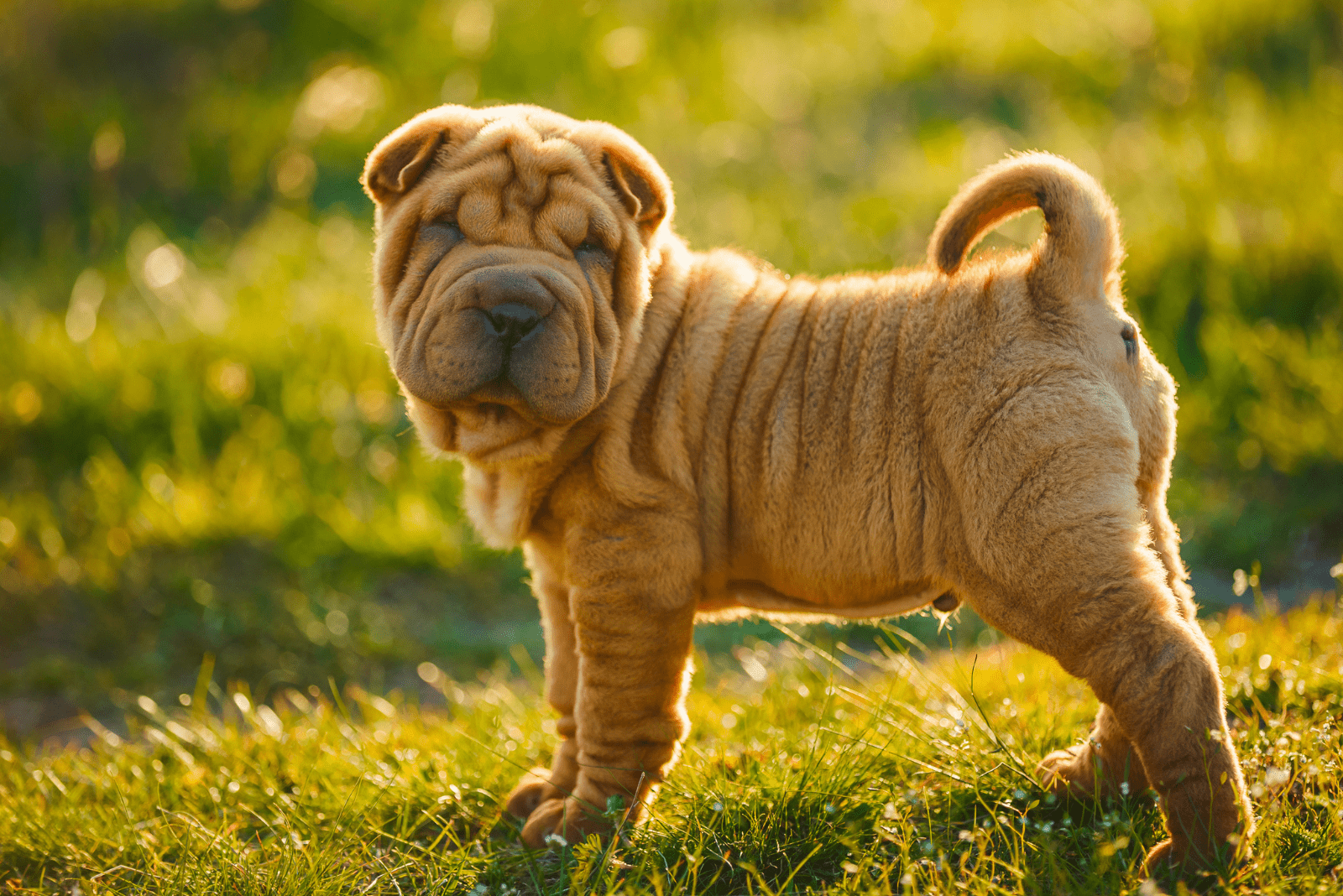
This is calculated through the dog’s RER (resting energy requirement), and is mostly accurate, but again, I’d only use it as a baseline and adjust according to your dog’s specific needs or bodily functions.
The formula is as follows:
30 x (body weight in kilograms) + 70 = RER for medium-sized dogs
By the end of this period, your dog would have attained adulthood fully by reaching his adult weight and reaching mental maturity to some degree.
Some dogs may need a month more or less depending on their developmental processes, but you can expect his puppy period to end between the 14th to 18th month.
Adulthood (1.5-7 Years Of Age)
There aren’t many exciting new changes that are going to happen over your Shar-Pei’s adult life unlike his puppy period, but they’re gonna be a lot more independent now than they were before.
The accumulated mass will start turning to muscle if you keep up with his physical exercise which will help him live longer by providing better support for his weight and improving his overall health.
As time passes and he reaches his twilight years, his metabolism will gradually start to slow down at which point you should start reducing his portions and overall calorie intake so he doesn’t end up becoming obese.
Senior Years (7+ Years Of Age)
In this period, the dog’s metabolism continues to slow down still as it can’t keep up with old age. Some people swap out the adult dog food for something softer, more adequate for senior dogs.
Something that’s easier to digest so the body doesn’t have to put as much energy into it.
It’s also the period where most of the health issues will start to pop up, especially ones related to posture or similar, like bloat, something a Shar-Pei is relatively prone to getting.
Other than that, everything else mostly stays the same for the rest of your canine companion’s life.
What Affects A Shar-Pei’s Growth?
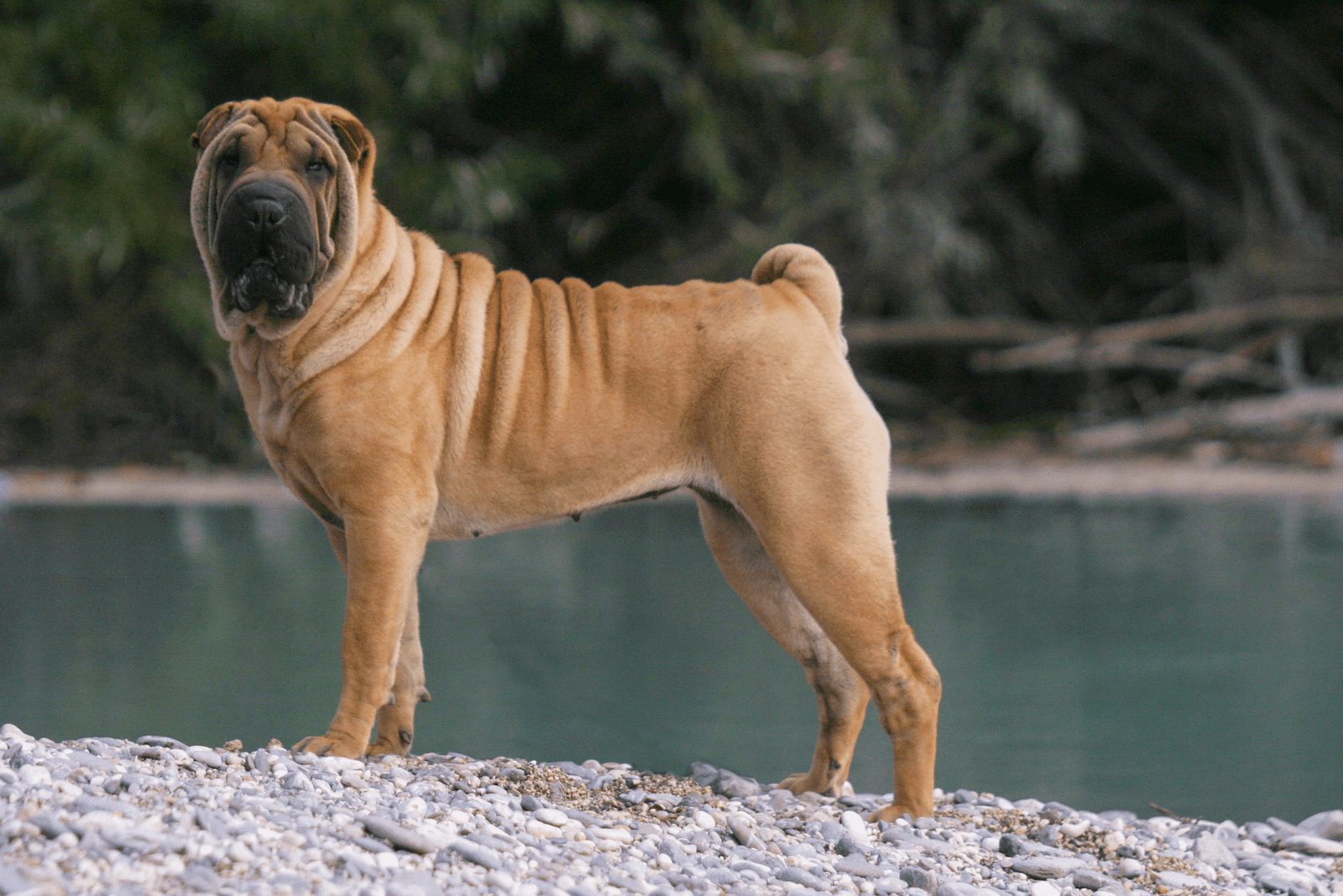
Well, it’s mostly the standard stuff that you’d expect, but I figured I may as well delve into a little bit more detail for those interested.
There are 3 main aspects that determine how well or poorly a dog will grow to his usual size:
His Genes
Genetics are the main culprit of health issues, visual appearance, and overall growth rate in a dog, and the Shar-Pei is no exception to that rule.
While it won’t affect him as it would other dogs with wilder growth patterns, genes may still lead to a naturally slower metabolism which may manifest as your dog having less overall energy or eating less but gaining more than other dogs.
Should this be the case, it’s best to call on a vet or pet nutritionist for advice on how to adjust his diet so he can still gain the necessary nutrients while maintaining a healthy weight.
His Diet
The second most important part that determines your dog’s growth is what he eats, his overall diet.
Getting adequate nutrition is key in a dog’s puppy years as it’s the period where almost all of the growth happens and he should be reaching his adult weight by the end of it.
Of course, being both under and overweight is bad in its own right, so it’s good to try and stay within the health range for the given month.
A few pounds over or under is fine, but try not to overdo it.
That said, it can’t just be any type of food, it needs to have the necessary ingredients to facilitate the growth in the first place.
The food needs to have plenty of DHA and EPA to help him develop his cognitive function at an adequate level.
Phosphorus and calcium are also necessary to strengthen bone and joint tissue as hip and elbow dysplasia are rampant among medium and large sized dogs, especially later in life.
Naturally, other minerals and nutrients are necessary, as is the protein which you feed him to help build proper lean muscle structure.
Prebiotics and probiotics are a good addition too to strengthen your Shar-Pei’s overall immune system, as are antioxidants for further improvements to bodily health by preventing damage to it from free radicals.
The Amount Of Exercise He Gets Daily
Finally, exercise is the last key component to unlocking the healthy path of a dog’s growth.
Shar-Pei do appear chunky, but they’re muscle machines, bears in dog’s clothing to a degree given their ferocity when they need to defend others and their sheer power.
Make sure your dog gets the adequate amount of his daily exercise to help keep everything running and to burn some calories off.
Thankfully, the Chinese Shar-Pei isn’t that demanding in terms of that, only really needing about 2, maybe 3 walks a day to satisfy his needs.
If you can meet these conditions, at least the last two that you can influence, then you’re going to have a real healthy pooch on your hands.
How Big Do Shar-Pei Get?
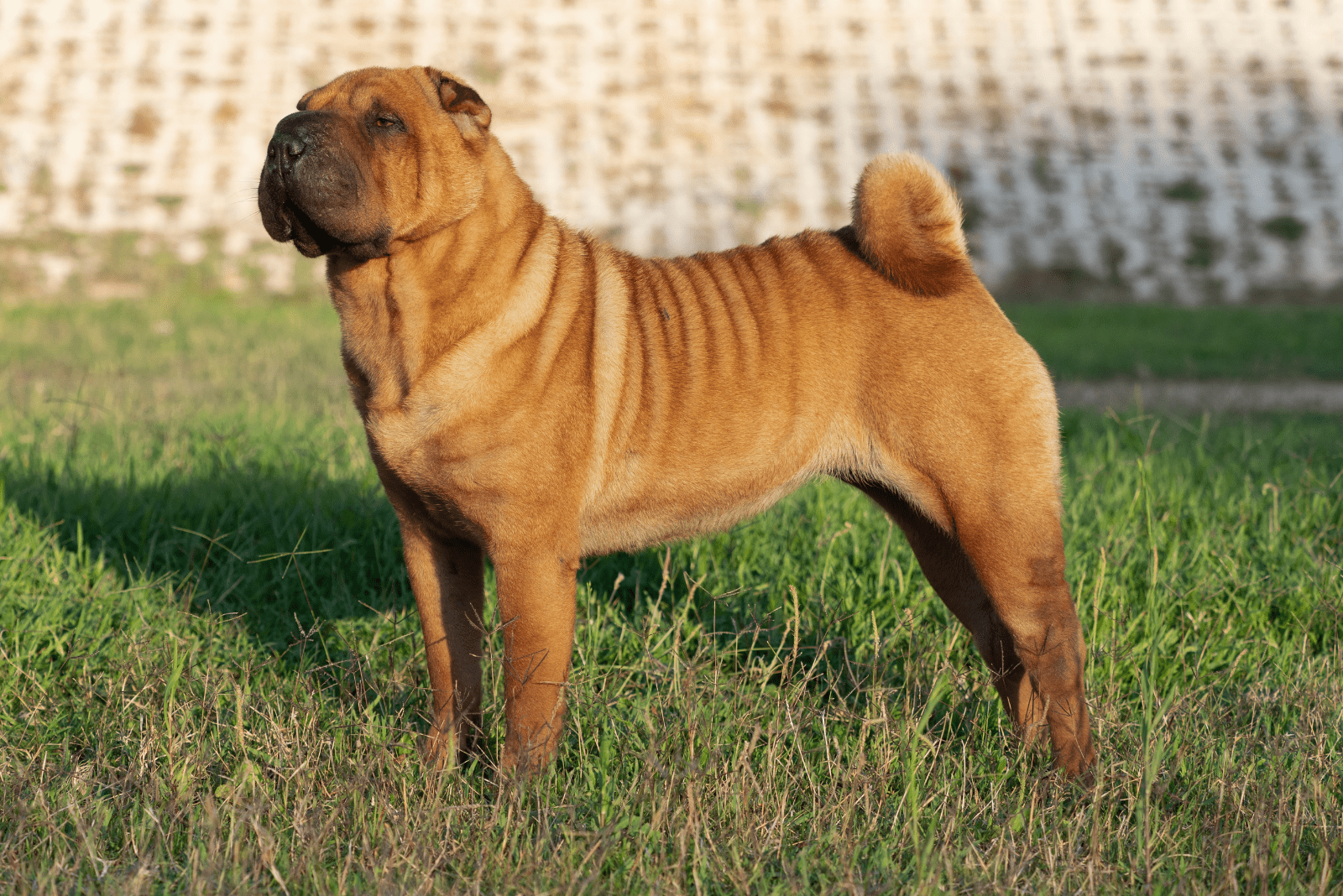
The final height and weight of a Shar-Pei varies based on their gender.
The average size of a male Shar-Pei equates to around 18-20 inches at its peak paired together with around 63-66 lbs.
On the other hand, a female Shar-Pei will reach a height of 17-19 inches and about 53-56 pounds of weight, a good amount less than her male counterpart despite similar heights.
If your dog overshoots this or undershoots it by a little, it’s no cause for concern.
It just means that you’ll have to adjust his diet accordingly.
However, if the weight or height are a bit too much under the average ranges, you should take him to a vet to see if there are any underlying health issues that are causing this, like parasitic worms or similar.
FAQs
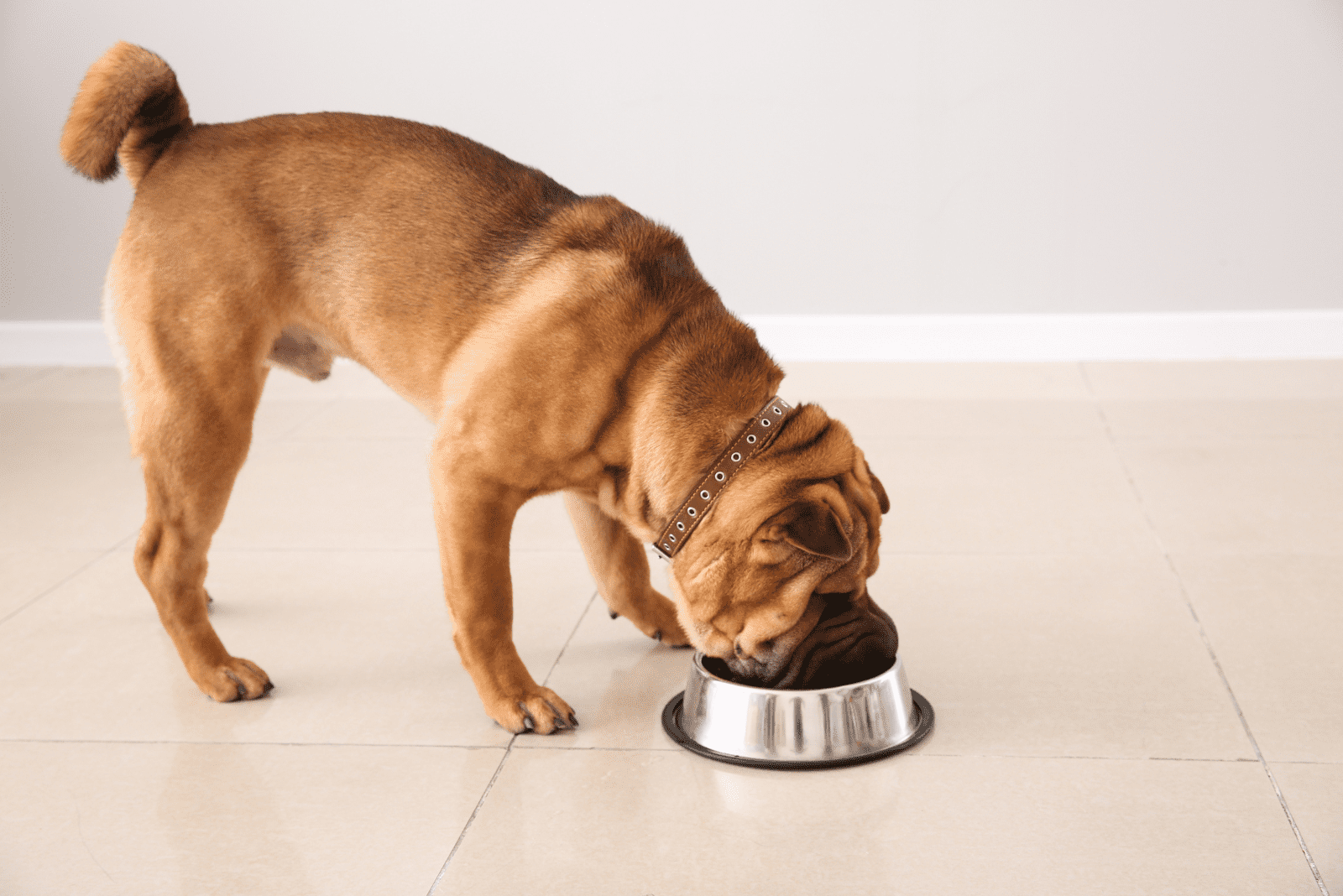
As far as Shar-Pei are concerned, there are two different thresholds to look out for when they’re supposed to finish their growth, the height and the weight.
As I’ve mentioned earlier, you’ll have your Shar-Pei stop growing when he’s around 9-10 months of age, the other 5 to 9 months after that are mostly for mental maturity and weight gain.
So, weight wise, your Shar-Pei will usually hit his final size at around month 14-18 of his life, depending on the factors mentioned prior like genetics, diet and amount of exercise.
Obviously, your dog may continue to gain extra weight or lose some over the course of his life, but that mostly has to do with the way you’re feeding him or any potential diseases.
As long as you keep him on a balanced diet, you shouldn’t be seeing any further fluctuations in his overall mass, and certainly not in his height.
The Chinese Shar-Pei doesn’t need all that much exercise to be able to maintain proper muscle structure, surprisingly enough.
All he really needs is 2 to 3 walks a day to do his business and some light exercise so he doesn’t just lounge around the house and so he can keep in shape.
Some fresh air will also do him some good.
The walks are suggested to be around 30 minutes to an hour, but you can break it off into more, shorter walks, as long as he gets at least a good 1-2 hours of physical activity a day.
The average lifespan of a Shar-Pei usually ends up being 9-11 years due to the many health problems that they may contract in their old age.
It’s also the expected age of a medium sized dog breed, though exceptionally healthy ones can move that threshold up to 10-12 years.
However, their body simply becomes too old at that point and doesn’t allow them to maintain their usual level of activity.
Shar-Pei have two different coat types that they can have, either the standard ‘horse coat’, or the ‘brush coat’ which has slightly longer hairs than the former.
As far as the color of the coats is concerned, there are a good number of variants aside from the standard brownish tan one.
They’re split between standard and non-standard ones as well, with slight variations between one another, but different enough to be considered a color on their own.
As far as standard coat color options go, they are as follows:
• Tan
• Orange
• Isabella
• Blue
• Cream
• Black
• Champagne
• Agouti
• Fawn
• Lilac
• Liver
• Sable variants of the prior colors
And, as for the non-standard ones:
• Variants of standard coat colors with added white markings
• Saddle marked coats
• Coats with tan points
• Brindle
• Brindled tan
• Creeping tan
• Solid white coats
There are surprisingly many, however, a lot of the non-standard ones are nigh impossible to find except in a handful of breeders.
It honestly depends on whether you want to have just a family dog or if you want to take him out to shows.
On average, you’ll be paying somewhere between $750 to $1500 for a regular Shar-Pei trained and bred to be a family dog that’ll help guard the house.
However, for show dogs, those get a lot pricier.
The floor stays at around 800-ish dollars, but the ceiling can hit pretty high, upwards from $2500 to $3000 in rare cases, depending on which breeder you go to and how famous they are.
Do keep in mind that this is just the price of the puppy alone, there are prices of the dog gear you need to buy to consider as well, be it annual food expenses, leashes, collars, dog beds, crates, vaccinations, toys etc.
All of that racks up to quite the sum, so be prepared to bore a big hole in your wallet if you’re adamant about getting this royal pooch.
Chinese Shar-Pei, much like any other dog, isn’t immune to the health issues that many dogs often face.
Given his proportions, he’s prone to quite a number of them too.
Bone Problems
The most common ones revolve around his joints, elbow and hip dysplasia which can either occur at birth, or gradually develop over time as their joint quality deteriorates, hence the calcium and phosphorus recommendation in foods.
Patellar luxation also counts among those issues relating to bone structure.
Skin Infections
Due to the breed’s many skin folds, a Shar-Pei is also prone to many skin infections from all the dirt and other foreign material that may get stuck in there, or just general irritation from friction.
That’s why it’s always handy to feed him food that helps improve skin quality.
Usually, finding food that contains Omega-3 or 6 fatty acids or shampoo with Aloe Vera helps out the best in preventing that from happening.
Eye Problems
Then, there’s the eye problems that can occur like retinal dysplasia, glaucoma, entropion and cataracts.
Usually unavoidable, but that’s why feeding them food with vitamin A and E is beneficial in helping minimize the chances of these problems appearing in the first place.
Bloat
The Shar-Pei is also prone to bloat, which is a condition where his intestines can twist up and trap gas in, cutting off blood flow which can be fatal if left unnoticed.
In dogs, this normally happens due to them not chewing their food or eating too much, causing the stomach to distend and expand which then leaves it more prone to tangling up when it tries to retract back after the fact.
Make sure you teach your dog proper chewing habits and to pace his feeding to minimize the risk of this issue as best you can.
Parasites
Parasitic worms are another, pretty serious problem that can occur due to ingesting contaminated food or something foreign on the ground.
The most common ones are ringworms, hookworms and tapeworms.
Whichever ones they are, they’re going to suck up most of the nutrients from the food your dog is ingesting and lead to rapid weight loss and overall malnourishment, lack of energy and nausea.
So, if you notice your dog appearing sluggish and out of energy, take either him or a stool sample to the vet to determine whether or not he has worms or if it’s another issue altogether.
Thankfully, dealing with worms nowadays is relatively easy when discovered, it’s mostly about the damage they can do while they remain untreated.
If your dog contracts worms during the puppy period, it could be a serious cause for concern.
He won’t be getting the nutrients that he needs to continue growing at a healthy rate, and his growth would be stunted, be it through an inadequate height or being severely underweight.
That’s why breeders and veterinarians alike recommend regular deworming every 2 months or so even if the stool result ends up being negative, just to be on the safe side of things.
Portosystemic Liver Shunt
One of the more fatal problems that can occur is portosystemic liver shunt which is what happens when an abnormal connection forms between the portal vein on the liver and one of its branches.
This causes the blood that normally goes through the GI system to be fed directly to the rest of the bloodstream.
The reason why this is bad is because the blood in the GI system is littered with bacteria and other material that shouldn’t, by any means, enter the main bloodstream prior to filtration.
While it can be handled with surgery that has a 95% success rate, the symptoms don’t always recede.
And the symptoms are often severe, ranging from diarrhea and vomiting to full on seizures which get progressively worse over time and you may end up having to put your dog down so he doesn’t have to suffer.
These dogs usually live anywhere from 2 months to 2 years depending on how many shunts have formed and how well the treatment options are working.
The dogs with successful surgical correction will usually feel normal in a month or two and can continue on living their life.
Difficulties Breathing
The Shar-Pei, much like the bulldog, is brachycephalic, meaning that his facial features can and will obstruct their airways so they’ll have difficulties breathing.
It’s definitely not ideal, but there’s very little that can be done about it. Just make sure to not make your dog do any heavy physical exertion and he should be as good as he can be.
Thyroiditis
Finally, autoimmune thyroiditis is another one they’re relatively prone to which can mean that your dog is more prone to heart disease and may display an increased appetite as well as increased urination and defecation.
To put it simply, it won’t, if done at the right time. Your dog’s reproductive organs don’t play a big part in his overall growth after its growth plates are closed.
It may make the dog appear less active overall due to lack of testosterone or estrogen and your dog may have some depressive episodes for a bit after the procedure, but all of that gets sorted in about two weeks time.
If the procedure is done prior to the closure of said growth plates, however, you may end up having a bigger dog than you had expected prior, which is definitely a bad thing as his body wasn’t built to support itself being that big.
The proper time to do so is when he’s around 4 to 9 months of age which is when his growth would be slowing down overall and your dog would be reaching his full size.
I personally suggest sticking as close to the 9th month as possible, but without more detailed knowledge about your pooch, I recommend consulting your pet’s veterinarian about it.
They’ll have the information available to them to make the correct decision regarding the matter and are there to help fix any potential side effects that may occur due to the process of spaying or neutering.
It’s a relatively simple thing to do, as long as he can stay still.
All you’ll really need is some measuring tape, something to mark the height like a pen, pencil or marker or anything of the sort, as long as you can clean it off later, and a carpenter’s level.
If you have a specific method of calming your dog down and making him stay put, use that too as you’ll need it, be it treats or his favorite toy, or something else entirely.
The first thing you’ll need to do is similar to what you’d do when measuring your kids. Place the dog next to a door frame and have him properly positioned, standing at attention.
Once that’s done, you’ll need to find out where his withers are.
These are found on the shoulder blades and they’re at the very tip.
While it would be easy to find in some dog breeds, the Shar-Pei’s skin makes it challenging without feeling for them.
When you’ve found it, grab the carpenter’s level and place one end on the withers and the other up against the door frame or the wall until you get the bubble to align in the middle so you know its level and you can get an accurate measure.
Mark the spot on the wall and then your doggo is free to go about his own business.
Once you’ve marked it, grab the measuring tape and measure the distance from the floor to the marked spot and you have your dog’s exact height now.
In Conclusion
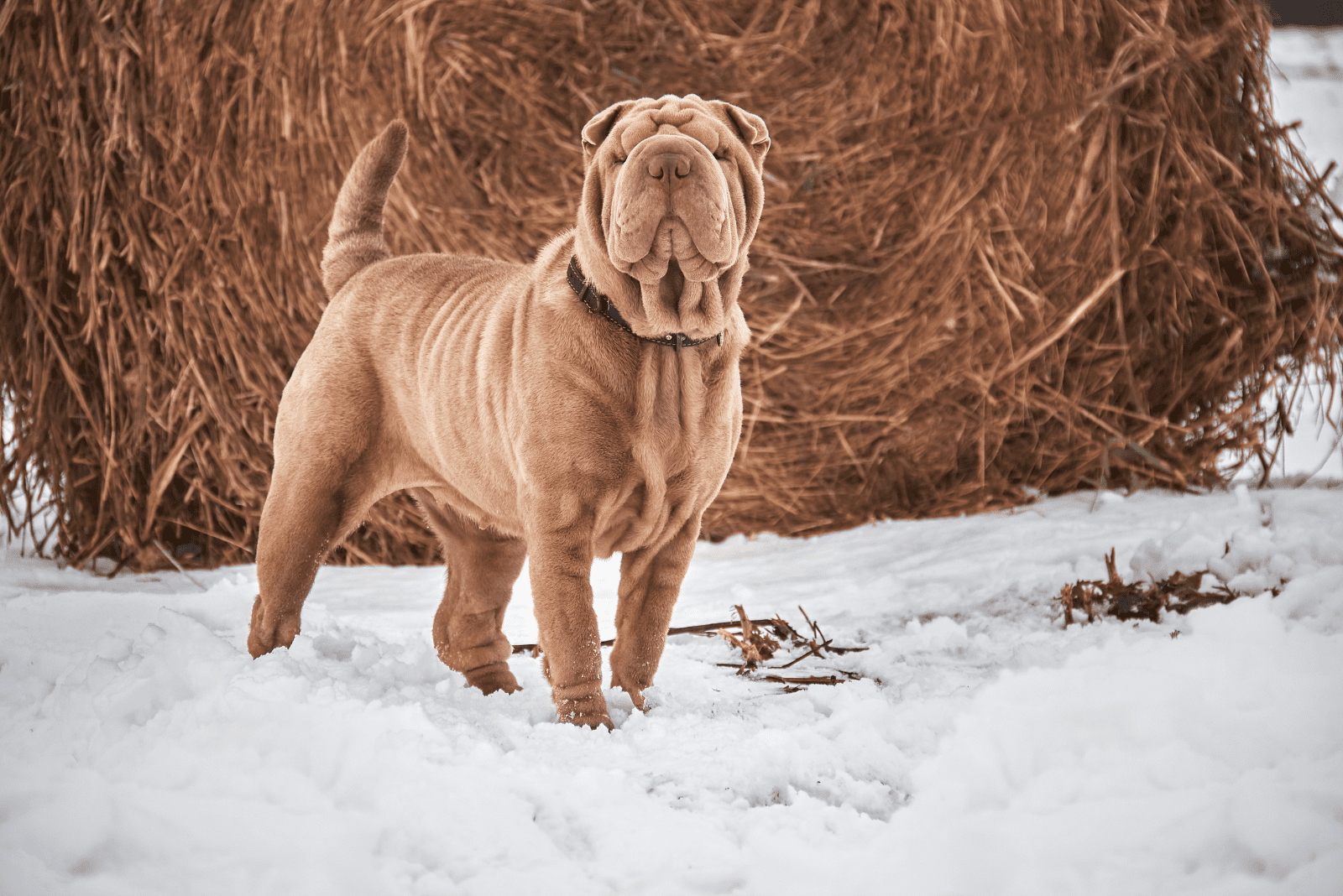
The Shar-Pei growth chart helps serve as a good reference sheet of the average ranges of both weight and height that we can look at while the dog goes through his puppy years.
They’re meant to be as a guide, not a law as there are plenty of factors that can influence a dog’s final height and weight as well as how long it takes him to get there.
All you need to do is make sure you provide your dog with as healthy a lifestyle as you can, and, if you see anything unusual happening to him, physically or behavior-wise, make sure to ask your vet for advice on the matter.
However, I have no doubts that you’ll be able to manage this with little issue and that you’ll be able to provide your dog with a healthy life and a loving home. Until next time.
RELATED LINKS:
- 17 Low Energy, Medium-Sized Dogs + Some Lazy Dog Breeds
- Shar Pei Mixes: 28 Hybrid Pups That Will Melt Your Heart
- Shar-Pei Cost: The Price Is Sharp, Eh?
- 18+ Chinese Shar-Pei Colors: The Decision Will Be A Hard One
- Bear Coat Shar-Pei: A Teddy Bear Dog That’s Right For You?
- 20 Chinese Dog Breeds—The Good, The Bad, And The Pugly
